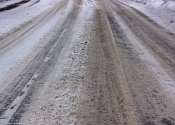US begins review that could eventually lead to PVC ban
The US Environmental Protection Agency (EPA) on Thursday announced a review that could eventually lead to the end of PVC plastic production—impacting everything from records to rubber ducks.

The US Environmental Protection Agency (EPA) on Thursday announced a review that could eventually lead to the end of PVC plastic production—impacting everything from records to rubber ducks.
Environment
Dec 14, 2023
20
848

Transparent wood promises to be an environmentally friendly substitute for glass or plastic used for making car windshields, see-through packaging and biomedical devices, according to a study.
Biochemistry
Oct 18, 2022
1
280

Japanese scientist Kikunae Ikeda first proposed umami as a basic taste—in addition to sweet, sour, salty and bitter—in the early 1900s. About eight decades later, the scientific community officially agreed with him.
Cell & Microbiology
Oct 5, 2023
1
393

(PhysOrg.com) -- When a river flows into the sea, the location is more than just a haven for water commerce. The mixing of fresh and salt water that occurs at an estuary also dissipates energy, as the different salinity waters ...

(PhysOrg.com) -- Chemists have for a long time been interested in a type of molecule that is literally tied up into a knot. This is where atoms are bonded together to form strands, which are then twisted around one another ...

A chemist at the University of Cincinnati has come up with a novel way to study the thermodynamic properties of molten salts, which are used in many nuclear and solar energy applications.
Materials Science
Jul 22, 2022
0
1203

For decades, the fields of physics and chemistry have maintained that the atoms and molecules that make up the natural world define the character of solid matter. Salt crystals get their crystalline quality from the ionic ...
Analytical Chemistry
Jun 7, 2023
0
572

The planet's demand for salt comes at a cost to the environment and human health, according to a new scientific review led by University of Maryland Geology Professor Sujay Kaushal. Published in the journal Nature Reviews ...
Earth Sciences
Oct 31, 2023
8
247

The research group led by Leiden chemist Marc Koper has discovered a catalyst that minimizes the production of chlorine gas during salt water electrolysis. The invention can enable the direct production of hydrogen from seawater. ...
Materials Science
Aug 10, 2018
0
61

Muhammad Rabnawaz, an associate professor in Michigan State University's School of Packaging and recent inductee into the National Academy of Inventors, has always believed that the most brilliant solution is also the simplest.
Polymers
Sep 8, 2023
3
238
The chloride ion is formed when the element chlorine, a halogen, picks up one electron to form an anion (negatively-charged ion) Cl−. The salts of hydrochloric acid HCl contain chloride ions and can also be called chlorides. The chloride ion, and its salts such as sodium chloride, are very soluble in water. It is an essential electrolyte located in all body fluids responsible for maintaining acid/base balance, transmitting nerve impulses and regulating fluid in and out of cells.
This text uses material from Wikipedia, licensed under CC BY-SA